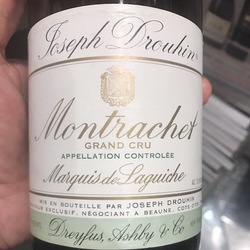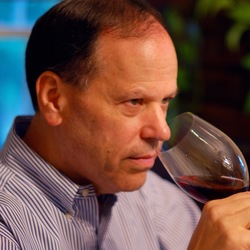Pierre Emile Michel
Michel et Pierre Choquet
Les Ormes de Lagrange Red Bordeaux Blend 2015
Stone fruit. Dry. Pear and cassis. Maybe plum. Who knows? — 7 years ago
Château Lynch-Bages
Grand Cru Classé Pauillac Cabernet Sauvignon Blend 2000
The 2000 is delicious but, it is evolving at a glacial pace. Out of magnum.
On the nose, touch of barnyard, glycerin, ripe; blackberries, dark cherries, black raspberries, plum, strawberries & cherries. Vanilla, dry clay, limestone, river stones, just a touch of pyrazines & bandaid, dark,,turned, moist earth, dry grass and dry & fresh dark florals.
The body is full, round & sexy. Dry softened, sweet tannins. ripe; blackberries, dark cherries, black raspberries, plum, strawberries & cherries. Vanilla, dry clay, limestone, river stones, just a touch of pyrazines & bandaid, fresh tobacco leaf, saddle-wood, dry underbrush, dark, turned, moist earth, dry grass and dry & fresh dark florals. The acidity is magnificent. The structure, tension, length and balance are sensational. The finish is drop dead gorgeous. I’d still hold mine another 5 years as long as you have 3-4 bottles for more 5 year increments.
Photos of, their Estate vines, Clyde Beffa-Owner of K&L Wine Merchants, Owner of Chateau Lynch Bages - Jean-Michel Cazes, guests of the dinner and a sunset view from their Estate.
Producer notes and history...Lynch Bages takes its name from the local area where the Chateau is located in Bages. The vineyard of what was to become Lynch Bages was established and then expanded by the Dejean family who sold it in 1728 to Pierre Drouillard.
In 1749, Drouillard bequeathed the estate to his daughter Elizabeth, the wife of Thomas Lynch. This is how the estate came to belong to the Lynch family, where it remained for seventy-five years and received the name Lynch Bages. However, it was not always known under that name.
For a while the wines were sold under the name of Jurine Bages. In fact, when the estate was Classified in the 1855 Classification of the Medoc, the wines were selling under the name of Chateau Jurine Bages. That is because the property was owned at the time by a Swiss wine merchant, Sebastien Jurine.
In 1862, the property was sold to the Cayrou brothers who restored the estate’s name to Chateau Lynch family.
Around 1870, Lou Janou Cazes and his wife Angelique were living in Pauillac, close to Chateau Pichon Longueville Baron. It was here that Jean-Charles Cazes, the couple’s second son, was born in 1877.
In the 1930’s, Jean-Charles Cazes, who was already in charge of Les-Ormes-de-Pez in St. Estephe agreed to lease the vines of Lynch Bages. By that time, the Cazes family had history in Bordeaux dating back to the second half of the nineteenth century.
This agreement to take over Lynch Bages was good for both the owner and Jean Charles Cazes. Because, the vineyards had become dilapidated and were in need of expensive replanting, which was too expensive for the owner. However, for Cazes, this represented an opportunity, as he had the time, and the ability to manage Lynch Bages, but he lacked the funds to buy the vineyard.
Jean-Charles Cazes eventually purchased both properties on the eve of the Second World War. Lynch Bages and Les-Ormes-de-Pez have been run by the Cazes family ever since. In 1988, the Cazes family added to their holdings in Bordeaux when they purchased an estate in the Graves region, Chateau Villa Bel Air.
Around 1970, they increased their vineyards with the purchase of Haut-Bages Averous and Saussus. By the late 1990’s their holdings had expanded to nearly 100 hectares! Jean-Michel Cazes who had been employed as an engineer in Paris, joined the wine trade in 1973. In a short time, Jean Michel Cazes modernized everything at Lynch Bages.
He installed a new vat room, insulated the buildings, developing new technologies and equipment, built storage cellars, restored the loading areas and wine storehouses over the next fifteen years. During that time period, Jean Michel Cazes was the unofficial ambassador of not just the Left Bank, but all of Bordeaux. Jean Michel Cazes was one of the first Chateau owners to begin promoting their wine in China back in 1986.
Bages became the first wine sent into space, when a French astronaut carried a bottle of 1975 Lynch Bages with him on the joint American/French space flight!
Beginning in 1987, Jean-Michel Cazes joined the team at the insurance company AXA, who wanted to build an investment portfolio of quality vineyards in the Medoc, Pomerol, Sauternes, Portugal and Hungary.
Jean-Michel Cazes was named the director of the wine division and all the estates including of course, the neighboring, Second Growth, Chateau Pichon Baron.
June 1989 marked the inauguration of the new wine making facilities at Lynch Bages, which was on of their best vintages. 1989 also marked the debut of the Cordeillan- hotel and restaurant where Sofia and I had one of our best dinners ever. A few years after that, the Village de Bages with its shops was born.
The following year, in 1990, the estate began making white wine, Blanc de Lynch Bages. In 2001, the Cazes family company bought vineyards in the Rhone Valley in the Languedoc appellation, as well as in Australia and Portugal. They added to their holdings a few years later when they purchased a vineyard in Chateauneuf du Pape.
In 2006, Jean-Charles Cazes took over as the managing director of Chateau Lynch Bages. Jean-Michel Cazes continues to lead the wine and tourism division of the family’s activities. Due to their constant promotion in the Asian market, Chateau Lynch Bages remains one of the strongest brands in the Asian market, especially in China.
In 2017, Chateau Lynch Bages began a massive renovation and modernization, focusing on their wine making, and technical facilities. The project, headed by the noted architects Chien Chung Pei and Li Chung Pei, the sons of the famous architect that designed the glass pyramid for the Louvre in Paris as well as several other important buildings.
The project will be completed in 2019. This includes a new grape, reception center, gravity flow wine cellar and the vat rooms, which will house at least, 80 stainless steel vats in various sizes allowing for parcel by parcel vinification.
The new cellars will feature a glass roof, terraces with 360 degree views and completely modernized reception areas and offices. They are not seeing visitors until it’s completion.
In March, 2017, they purchased Chateau Haut Batailley from Françoise Des Brest Borie giving the Cazes family over 120 hectares of vines in Pauillac!
The 100 hectare vineyard of Lynch Bages is planted to 75% Cabernet Sauvignon, 17% Merlot, 6% Cabernet Franc and 2% Petit Verdot. The vineyard has a terroir of gravel, chalk and sand soils.
The vineyard can be divided into two main sections, with a large portion of the vines being planted close to the Chateau on the Bages plateau. At their peak, the vineyard reaches an elevation of 20 meters. The other section of the vineyard lies further north, with its key terroir placed on the Monferan plateau.
They also own vines in the far southwest of the appellation, next Chateau Pichon Lalande, on the St. Julien border, which can be used in the Grand Vin. The vineyard can be split into four main blocks, which can be further subdivided into 140 separate parcels.
The average age of the vines is about 30 years old. But they have old vines, some of which are close to 90 years old.
The vineyards are planted to a vine density of 9,000 vines per hectare. The average age of the vines is about 30 years old. But they have old vines, some of which are close to 90 years old.
Lynch Bages also six hectares of vine are reserved for the production of the white Bordeaux wine of Chateau Lynch Bages. Those vines are located to the west of the estate. They are planted to 53% Sauvignon Blanc, 32% Semillon and 15% Muscadelle. On average, those vines are about 20 years of age. Lynch Bages Blanc made its debut in 1990.
To produce the wine of Chateau Lynch Bages, vinification takes place 35 stainless steel vats that vary in size. Malolactic fermentation takes place in a combination of 30% French, oak barrels with the remainder taking place in tank.
The wine of Chateau Lynch Bages is aged in an average of 70% new, French oak barrels for between 12 and 15 months. Due to the appellation laws of Pauillac, the wine is sold as a generic AOC Bordeaux Blanc, because Pauillac does not allow for the plantings of white wine grapes.
For the vinification of their white, Bordeaux wine, Blanc de Lynch-Bages is vinified in a combination of 50% new, French oak barrels, 20% in one year old barrels and the remaining 30% is vinified in vats. The wine is aged on its lees for at least six months. The white wine is sold an AOC Bordeaux wine.
The annual production at Lynch Bages is close to 35,000 cases depending on the vintage.
The also make a 2nd wine, which was previously known as Chateau Chateau Haut Bages Averous. However, the estate changed its name to Echo de Lynch Bages beginning with the 2007 vintage. The estate recently added a third wine, Pauillac de Lynch-Bages.
— 8 years ago


Blard & Fils
Cuveé Pierre Emile Pinot Noir 2015
Superb savoie. Another North Star 🌟 — 7 years ago
Philip Togni Vineyard
Napa Valley Cabernet Sauvignon 1992
One of my favorite Napa producers & vintages from Philip Togni.
On the nose, ripe, perfumed florals, creamy fruits of; blackberries, mulberries, dark cherries, black raspberries, raspberries, plum and strawberries on the glass edges. Vibrant baking spices; vanilla, light cinnamon, clove & nutmeg. Dark smooth spices, mocha chocolate with caramel, dark berry cola, notes of black licorice, sweet tar, forest floral, fresh tobacco leaf, just a touch of dry herbs, graphite, loamy clay and dark, fresh red florals with lavender & violets.
The body is, round, ruby, lush & full. The structure, tension, length have just tipped to the very beginnings of the waning stage but, the balance is incredible. Ripe, perfumed florals, creamy fruits of; blackberries, mulberries, dark cherries, black raspberries, raspberries, plum and strawberries on the glass edges. Vibrant baking spices; vanilla, light cinnamon, clove & nutmeg. Dark smooth spices, mocha chocolate with caramel, dark berry cola, chalky volcanic minerals with some grit, crushed dry rocks, notes of black licorice, sweet tar, forest floral, tobacco with ash, soft leather, saddle-wood, some underbrush, just a touch of dry herbs, graphite, loamy clay and dark, fresh red florals with lavender & violets. The round acidity is near perfect. The long, round, ripe, ruby, lush, well balanced finish sings on the palate for minutes.
Photos of, the Philip Togni vineyard, cellar staff-Salvador Sanchez, Philip Togni and his daughter Lisa and their barrel room.
Producer notes and history...Philip Togni was born in England and earned a degree (the Dipome National d’Oenologie) at the University of Bordeaux under Emile Peynaud. World famous Winemaker & mega Wine Consultant Michel Rolland also studied under Emile.
After his studies, Philip Togni moved to the Napa Valley in 1959. His first job was planting vines at Mayacamas.
In his career, he has been the Winemaker for Chalone, Chappellet, Cuvaison, Gallo, Inglenook and Sterling before starting his own winery.
Philip Togni was the Winemaker at Chapellet when they made one of the top wines from the 1960’s, the legendary 1969 Chapellet.
Philip Togni Vineyards were founded in 1975 when he purchased 25 acres atop Spring Mountain at an elevation of 2,000 feet. It took until 1981 to plant the vineyard. Sadly, he had to replant in the early 1990’s due to phylloxera.
The winery released its first vintage in 1983, a Sauvignon Blanc. However, he no longer produces white wine.
It took a few more years until the first Cabernet Sauvignon wines were produced at the estate. The debut vintage for Philip Togni Cabernet was the 1985 vintage. The initial vintages of Philip Togni were 100% Cabernet Sauvignon.
Philip Togni does not produce wines with high alcohol. A style from Napa that is sorely missed by me.
The style of his wines are Left bank. Left Bank wines had a big influence on his winemaking and the estate. However, if you have ever spent time looking at his labels for alcohol levels, they’re nowhere to be found.
During the 1980’s, the BATF allowed wineries to state that their wine had the alcoholic strength of a table wine, which was around 7% to 14%. For wineries that had not requested to change their labels, those wineries were not forced to provide specific percent of alcohol. If their labels remain unchanged from their label during the 1980’s, they were only required to state the wine as table wine.
The vineyard contains rocky and clay soils at 2,000 feet. Like Howell Mountain, the vineyard is well above the fog line, which allows for more sunlight and riper fruit.
The Estate is planted to 82% Cabernet Sauvignon, 15% Merlot, 2% Cabernet Franc and 1% Petit Verdot.
Philip Togni makes three wines:
Philip Togni Cabernet Sauvignon. It is aged in 40% new, French oak barrels for an average of 20 months before bottling.
Philip Togni Cabernet Sauvignon is a big, powerful, tannic when wine young. PT requires longer cellar time. It’s made from ripe mountain fruit that can easily take a 10 to 20 year to fully mature. And trust me, it is closer to 20 years of aging before it’s ready to drink.
Philip Togni also produces a second wine called “Tanbark Hill.” It’s named after a prominent hill near the Estate. Tanbark Hill is a 3 1/2-acre parcel of young vines. A very good second wine for less money.
The third wine is Philip Togni Ca’ and is sweet red dessert wine that is produced from the grape, Black Hamburgh. This grape was popular in the Napa Valley before Prohibition. Black Hamburgh is also know as Black Muscat. It is a grape variety derived from the crossing of the Schiava Grossa and Muscat of Alexandria by R. Snow of Bedforshire, England in 1850, according to my studies.
Philip Togni remains a family Winery. The estate is managed by Philip Togni (in his 90’s), his wife Brigitta Togni and their daughter Lisa Togni. In time, it is expected that Lisa Togni will take over the estate.
— 7 years ago

Michel Sarrazin et Fils
Les Dracy Givry Pinot Noir 2016
@ pierre et jean — 7 years ago
Pierre Gimonnet & Fils
Cuvée Cuis 1er Cru Brut Champagne
Since 1750 the Gimonnet family have been vine growers in the village of Cuis, supplying the great Champagne houses with grapes up until the 1930's recession, when sales fell. Today the estate is run by Pierre's sons, Michel and Didier, and in 1987 acquired the house of Larmandier Père et Fils based in Cramant. Classic BdB, light and refreshing, great balance, complex with perfectly ripe fruit, bubbles and mousse. Lingering finish with bright mineral ending. — 8 years ago










Renaud Konopnicki
Baccalauréat Pierre — 3 years ago